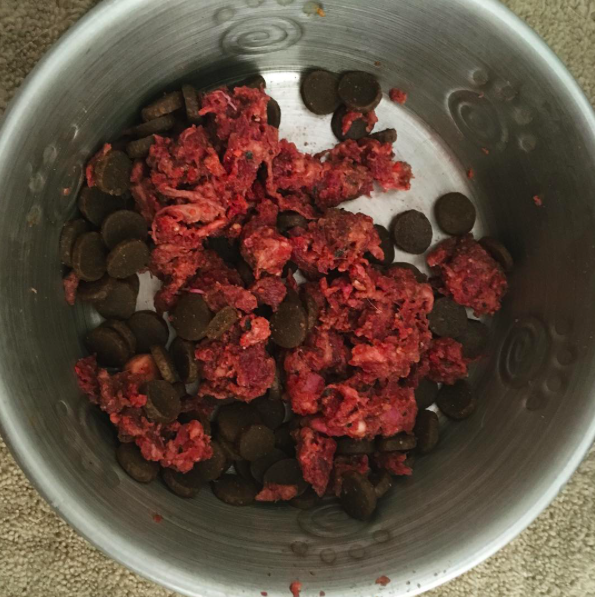
Dog food has been a passionate subject of mine for years, beginning with working with a raw dog food nutritionist in Fort Collins during college. So I ask you to step back for a moment and look at what you’re feeding your pet. Do you take your best friend’s nutrition as seriously as your own? Probably not, but some general healthy concepts pass right across into your dogs food, including nutritious proteins, eating real meat sources, consuming enough fruits and vegetables, vitamins and minerals. Until recently, it seemed as if we were feeding our dogs just as much junk food as we were feeding ourselves and then we sat back to wonder why 1 in every 3 dogs were suddenly dying of cancer. Are you feeding your dog the equivalent of doggie McDonalds?
I was in the pet store the other day, searching out antler chews for my dog when I overheard a woman asking the associate if he had something for her dog’s itching. While he could have just handed her medicated soothing spray to potentially calm short-term irritated skin, he knew that the cause was likely much deeper than a topical skin irritation. I had been in this scenario all too many times while working at Poudre Pet & Feed Supply in Fort Collins, Colorado.
I was dumbfounded the first time I realized what was in standard (as in grocery store, pet food aisle) dog food. It happened when I began working at a local natural and holistic feed store. My first exercise when I began work there was to walk around the store and read the labels of the dog foods. I attended trainings on dog food, health and wellness and I discovered an entirely new world of dog food. Is that really what had been killing everyone’s childhood dogs? Two of my own childhood dogs passed away to cancer, long before I knew anything about dog food.
I don’t want to get in depth on the ins and outs, do’s and don’ts of dog food, but rather I want to provide you with a few useful tools to increase your knowledge of what goes into various dog foods to help you make educated decisions while purchasing your dog food. With this, you can begin to directly increase the longevity of your dog, solve a few of the problems you didn’t realize were related to your dog’s food, and improve your dog’s overall health, based on the training and skills I have developed over the past six+ years of animal nutrition experience.

My time working at the pet store saw a lot of recurring questions, and I have a few brilliant and simple answers that might help you fix those problems.
“My dog is itchy.” Well, your dog might have fleas, or an odd skin reaction to something he brushed against outside, or more likely, if it is a long term problem, he might be allergic to some of the ingredients in his food. Case and point, did you buy your dog food at a typical grocery store? Is it dyed, or any color other than a shade of brown? Is there chicken in it? That might be your sign. Amazingly, because of how often chicken is used in dog foods, dogs have developed allergies to it. Your first step here is to switch your dog over to a dog food whose, here’s the key – first ingredient is listed as a real meat (and maybe not chicken (i.e. pork, beef, turkey) to see if that is the culprit). Dog food ingredients, similar to human food product ingredients must be listed in order of their predominance in the product. A low quality dog food lists its ingredients below:

Low quality dog food. This food is rated as 1 star on dogfoodadvisor.com
Why would we want to feed our dog corn? Dogs don’t eat corn. Now let me compare this example to a high quality dog food so you can see the difference:

You know that old healthy-eating adage, “If you can’t pronounce it, you should not be eating it,” that holds true here, too, except for the case of the last product having lactobacillus acidophilus fermentation, which is just a fancy way of saying yogurt, which we all know is good for us.
Note that the first ingredient in the quality dog food is a real food source, deboned beef, and it makes up the majority of the food. Additionally, the second, deboned pork, is another food source a wolf might base his diet on. For the 3rd ingredient, beef meal, if you are concerned, means the ground of bones of the animal. This is also natural and necessary for your dog’s health and digestion. As you go further down the list: kidney, liver, apples, carrots, kelp, all of these are just as healthy for your dog as they are his wild ancestors, as they are for you!

If you give a closer look to the first list of ingredients, aside from the corn (your dog’s body isn’t made to process corn), and chicken-by-product meal (which usually means ground up parts of the leftovers of a chicken’s body (as well as other parts of processing plant animals and bits) after it has been processed and after the healthy meat chunks have been taken away, including beaks, eyeballs, feathers, feet – which yes, a wild canine might eat in the wild on the side, but would not provide the healthy benefits of an actual cut of meat, and would not healthfully sustain a dog’s natural health alone), the rest of the ingredients are more of what you might find in a cake, or corn chips, or some other junk food. Now imagine basing your entire diet, morning and night, on junk food. You would develop some long-term health issues as well.
Further down the list of the lower quality dog food ingredients you’ll find all the preservatives we are told not to eat ourselves, added sugar!?, dangerous preservatives and additional vitamins that are added to meet the “balanced diet” requirements of a dog food. They do nothing to increase the overall health and vitality of the dog. Just like a bag of chips might keep you alive for awhile, but eventually the body will begin to shut down. It will not allow you to thrive, or help your body fight off diseases and allow it to function and fight disease to it’s fullest ability.
Yes, junk food tastes good to humans too. Corn chips, cupcakes, Cheetos, all have no real health value but boy do they taste good!
The most natural and healthy diet for a dog to eat is going to be a raw diet. This does not mean that he can eat just raw chicken or hamburger patties every day and be healthy. If you are considering creating your own raw dog food diet, look closely at the ingredients included in the specially formulated raw dog food patties you see. I’ll give you a hint, they include eggs, fruits, vegetables and a number of processed raw meats, a recipe I am not qualified to give to you, so I would direct you to raw food companies that either offer dehydrated or frozen raw, which allow your dog to thrive in his/her most primal state.
Fully balanced raw dog food diets include some mixture of:
- Muscle meat, often still on the bone
- Bones, either whole or ground
- Organ meats such as livers and kidneys
- Raw eggs
- Vegetables like broccoli, spinach, and celery
- Apples or other fruit
- Some dairy, such as yogurt (http://pets.webmd.com)
But for most people, $114 a month (on the cheap end) for a packaged, completely raw dog food diet for a 40 lb dog is not a feasible option, I know it isn’t for me, and I only have one dog. So I mix. I supplement Hank’s high quality kibble with 1/2 to 1/4 of each meal with a balanced raw food to provide him with the additional nutrients he needs to thrive.
Now I plead with you to go to your local natural pet food store and ask the knowledgeable staff to help you find a dog food that is right for your dog and his/her lifestyle. Read the the ingredient list too, so you know just what you are feeding your pet. Also beware of imposters that label their dog food as “natural” (there are a lot, natural doesn’t necessarily mean healthy), and remember my tips on main ingredients and the order in which they appear on the bag’s label. Switching to a raw diet can improve your dog’s itching/allergies, weight problems, dull coat, endless shedding, bad breath, and even *potentially* coprophagia!
NOTE: There are dogs that require specially formulated, special needs diets and thus, some of these general guidelines are not appropriate for all dogs. If you suspect that your dog might have more complex issues, it is best of course to consult your veterinarian.
I’d love to hear about your experiences or questions switching to a raw dog food or higher quality dog food, and the difference you saw in your furry friend!
SaveSave
SaveSave



Love this! 🙌🏼
Our dogs & cats are all fed a raw food diet and it has been amazing for them!
Everyone always asks me after petting my dog, “did you just give him a bath?” Feeding high quality food and raw makes THAT much of difference.